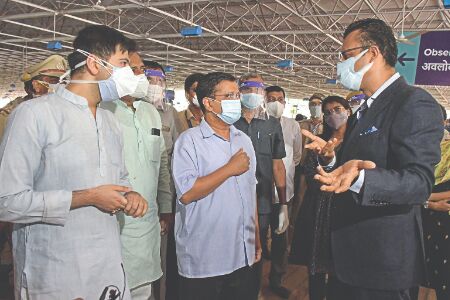Delhi reports marginal dip in deaths with 311 fatalities

New Delhi: The national Capital on Wednesday reported a marginal dip in COVID-related deaths with 311 fatalities against 338 a day earlier, while the positivity rate too dropped for the second consecutive day to reach 26.37 per cent, even as a higher number of 20,960 new infections were recorded in the last 24 hours, the Delhi Health Department said.
On Tuesday, the city had reported 19,953 new cases with a positivity rate of 26.73 per cent. Wednesday is the fourth day on the trot that the positivity rate has remained below 30 per cent.
The Delhi government claimed that all-round efforts and aggressive COVID management have resulted in a dramatic decrease in the positivity rate.
"Within just 10 days, Delhi's COVID positivity rate has reduced by 9 per cent. On April 26, Delhi reported a positivity rate of 35 per cent and on May 5, it came down to around 26 per cent," the government said in a statement.
The city had witnessed 338 deaths on Tuesday, 448 on Monday, the highest so far, 407 on Sunday, 412 on Saturday, 375 on Friday, 395 on Thursday, 368 on last Wednesday, 381 on last Tuesday, 380 on last Monday, and 350 on last Sunday.
The government said that during the last 10 days, the case positivity rate of COVID-19 has dropped by approximately 1 per cent each day.
"During these days, the Delhi government has not only ramped up testing, but also worked relentlessly in increasing the number of beds across Delhi," it said in the statement.
"The government is also giving an aggressive push to the vaccination drive, which will further help bring down the positivity rate in the coming days," it added.
Meanwhile, AAP MLA Raghav Chadha said Delhi received 555 tonnes of oxygen on Tuesday, the highest till now, as the city hospitals struggled with a shortage in the supply of the life-saving gas amid a spurt in Coronavirus cases.
He also said the Delhi government received 48 SOS calls regarding oxygen shortage and cylinders not being refilled, and they were addressed.
On the same day, Chief Minister Arvind Kejriwal visited Radha Soami Satsang Beas in Rajendra Nagar area to review the vaccination drive. During the visit, the CM said that if the Delhi government is provided with sufficient vaccines, then it can achieve the target of vaccinating the entire city in three months.
The vaccination drive has begun in both the private sector and in the government sector.
He said, "The process of vaccination has started successfully but I think that more supply of vaccines is the fundamental requirement right now. We have received a very less quantity of vaccines. Now the kind of infrastructure we have developed based on that we can ramp up the vaccination drive within 24 hours."
He also said the Delhi government will decide about extending the ongoing lockdown in the city depending on the number of Covid-19 cases.
"Visited vaccination center at Radha Soami Satsang Beas in Rajendra Nagar. Excellent arrangements. Youth are coming out in large numbers to get vaccinated. If the vaccine is provided in sufficient quantities, we can achieve our target of vaccinating the whole Delhi in 3 months," Kejriwal wrote on Twitter.
Meanwhile, a day after Lieutenant Governor (L-G) Anil Baijal directed for a survey of the COVID super-spreader spots in Delhi, teams were deployed in several districts for listing the crowded areas of the national capital, officials said on Wednesday.
In view of a rapid surge in coronavirus cases in Delhi, Baijal directed the district magistrates (DMs) and deputy commissioners of police (DCPs) to conduct an intensive survey in their areas and identify the potential "super-spreader" sites.
The exercise is currently on the drawing board and will be put on the ground after discussions with the DCPs concerned with teams deployed to identify the super-spreader sites such as markets and densely-populated areas, one of the DMs said.
The DMs and DCPs will identify places such as colonies, slums, markets and other crowded places in their areas that can potentially emerge as super-spreader spots once the lockdown is lifted.



